Complete Solutions to Illustration of chapter KINETIC THEORY OF GASES AND FIRST LAW OF THERMODYNAMICS of Class 11 book with complete answers and questions
| Class 11 | PHYSICS |
| Chapter | KINETIC THEORY OF GASES AND FIRST LAW OF THERMODYNAMICS |
| CENGAGE PHYSICS | Illustration |
| Number Of Questions | 55 |
| Academic Year | 2023-24 |
The mass of hydrogen molecule is `3.32xx10^(-27)` kg. If `10^(23)` hydrogen molecules strikes per second at 2 `cm^(2)` area of a rigid wall at an angle of `45^(@)` from the normal and rebound back with a speed of 1000 `ms^(-1)`, then the pressure exerted on the wall is
 05:02View Solution
05:02View SolutionA parallel beam of particles of mass `m` moving with velocity `v` impinges on a wall at an angle `theta` to its normal. The number of particles per unit volume in the beam is `n`. If the collision of particles with the wall is elastic, then the pressure exerted by this beam on the wall is
06:48View Solution(a) Calculate (i) root-mean-square speed and (ii) the mean energy of 1 mol of hyderogen at STP given that density of hydrogen is `0.09 kg//m^(3)`. (b) Given that the mass of a molecule of hydergen is `3.34 xx 10^(-27)` kg, calculate Avogadro's number. (c ) Calculate Boltmann's constant.
04:00View SolutionGiven molecular weight of hydrogen molecule is `M = 2.016 xx 10^(-3) kg//mol`. Calculate the root-mean-square speed of hydrogen molecules `(H_(2))` at `373.15 K (100^(@) C)`.
02:37View SolutionOne mole of oxygen occupies a volume of 24 L at `20^(@) C` and 1 atm pressure. What is the rms speed of an oxygen? Find the total translational kinetic energy and the total momentum of the molecules.
05:20View Solution`1 g` mole of oxygen at `27^@ C` and `1 ` atmosphere pressure is enclosed in a vessel.
(a) Assuming the molecules to be moving with `v_(r m s)`, find the number of collisions per second which the molecules make with one square metre area of the vessel wall.
(b) The vessel is next thermally insulated and moves with a constant speed `v_(0)`. It is then suddenly stoppes. The process results in a rise of temperature of the gas by `1^@ C`. Calculate the speed `v_0.[k = 1.38 xx 10^-23 J//K` and `N_(A) = 6.02 xx 10^23 //mol]`.06:11View SolutionA glass bulb of volume `400 cm^(3)` is connected to another bulb of volume `200 cm^(3)` by means of a tube of negligible volume. The bulbs contain dry air and are both at a common temperature and pressure of `20^(@) C` and 1.000 atm, respectively. The larger bulb is immersed in steam at `100^(@) C` and the smaller in melting ice at `0^(@)`. Find the final common pressure.
06:30View SolutionExplain whether (a) `T_(2) gt T_(1)`, (b) `P_(2) gt P_(1)` and (c ) `V_(2) gt V_(1)` or otherwise in Fig., which represent in isothermal, isobaric, and isochoric processes for the same mass of an ideal gas, respectively.
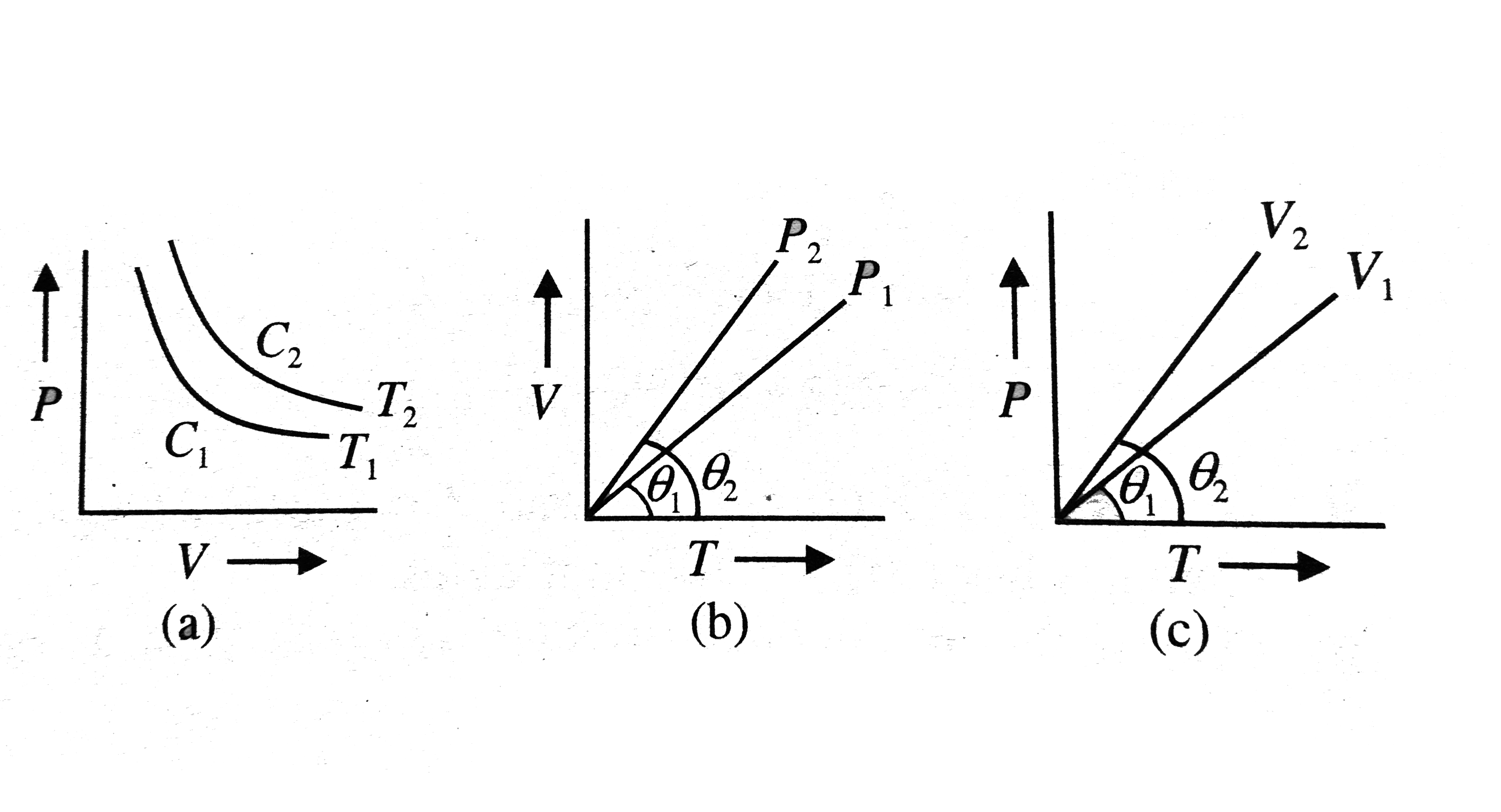 04:42View Solution
04:42View SolutionThe three diagrams below depict three different processes for a given mass of an ideal gas. What information can be drawn regarding the change of (a) pressure, (b) volume and (c ) temperature of the gas from the plots as shown in Fig., respectively.
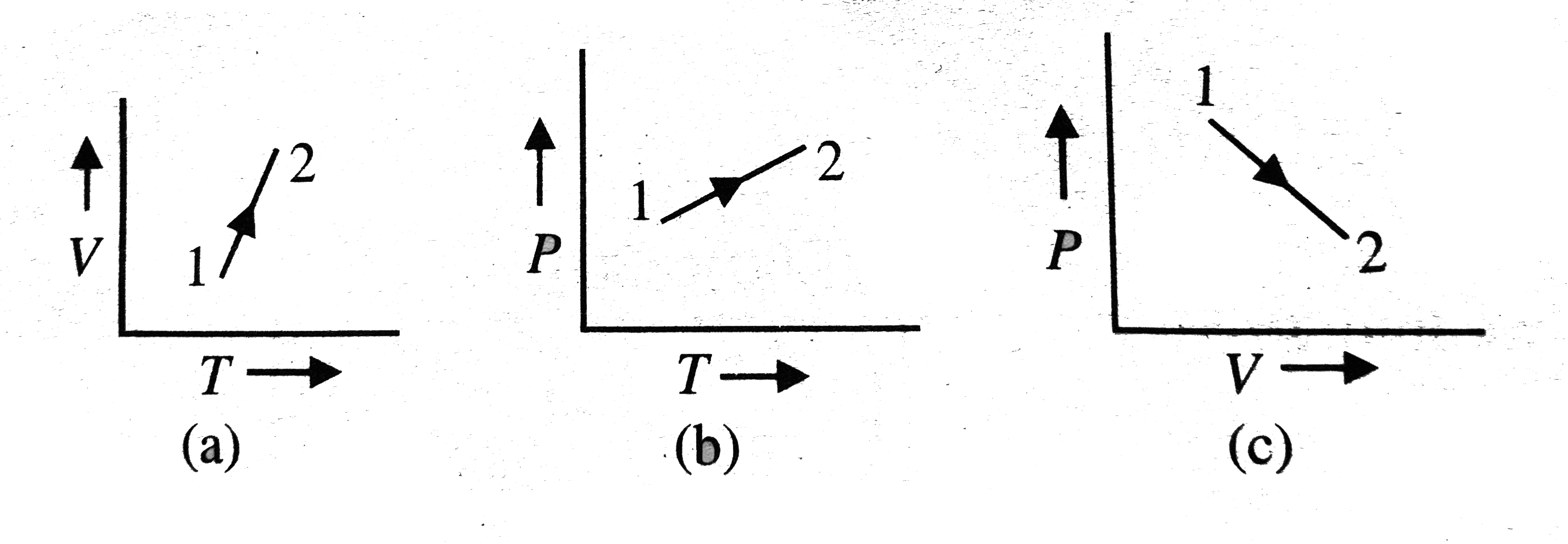 03:27View Solution
03:27View SolutionDraw the P-T and V-T diagrams of an isochoric process of n moles an ideal gas from pressure `P_(0)` volume `V_(0)` to pressure `4P_(0)`, indicating the pressures and temperatures of the gas in the initial and the final states.
03:12View SolutionDraw the P-T and V-T diagrams for an isobabaric process of expansion, corresponding to n moles of an ideal gas at pressure `P_(0)` from `V_(0)` to `2 V_(0)`
05:05View SolutionA cyclic process ABCA shown in the V-T diagram is performed with a constant mass of an ideal gas. Show the same process on a p-V diagram, In the figure, CA is parallel to the V-axis and BC is parallel to the T-axis.`
 `02:18View Solution
`02:18View SolutionCalculate (a) the average kinetic energy of translation of an oxygen molecule at `27^(@) C` (b) the total kinetic energy of an oxygen molecule at `27^(@)C` (c ) the total kinetic energy in joule of one mole of oxygen at `27^(@)`. Given Avogadro's number `= 6.02 xx 10^(23)` and Boltzmann's constant `= 1.38 xx 10^(-23) J//(mol-K)`.
04:39View SolutionA light container having a diatomic gas enclosed with in is moving with velocity v. Mass of the gas is M and number of moles is n,
a. What is the kinetic energy of gas w.r.t. centre of mass of the system ?
b. What is K.E. of gas w.r.t. ground ?03:29View SolutionTwo nonconducting containers having volume `V_(1)` and `V_(2)` contain monoatomic and dimatomic gases respectivley. They are connected as shown in figure. Pressure and temperature in the two containers are `P_(1), T_(1)` and `P_(2), T_(2)` respectively. Initially stop cock is closed, if the stop coc is opened find the final pressure and temperature.
05:04View SolutionAn ideal gas has a molar heat capacity at constant pressure of `Cp = 2.5 R`. The gas is kept in a closed vessel of volume `0.0083 m^(3)`, at a temperature of `300 K` and a pressure of 1.6 x 10^(6) Nm^(-2). An amount 2.49 x 10^(4) J of heat energy is supplied to the gas. calculate the final temperature and pressure of the gas.
06:36View SolutionA vessel of volume `0.2 m^(3)` contains hydrogen gas at temperature 300 K and pressure 1 bar. Find the heat required to raise the temperature to 400 K. The molar heat capacity of hydrogen at constant volume is `5 cal//mol K`.
03:01View SolutionAbout 0.014 kg nitrogen is enclosed in a vessel at temperature of `27^(@)C` How much heat has to be transferred to the gas to double the rms speed of its molecules ? `(R = 2 cal//mol K)`
05:01View SolutionA gaseous mixture enclosed in a vessel contains 1 g mole of a gas A (why `lamda`=5/3) and another gas B (with `lamda`=7/5) at a temperature T. The gases A and B do not react with each other and assumed to be ideal. The number of gram moles of B, if `lamda` for the gaseous mixture is 19/13 is
06:20View SolutionHow much heat energy should be added to the gaseous mixture consisting of 1 g of hydrogen and 1g of helium to raise it s temperature from `0^(@)C` to `100^(@)C`
(a) at constant volume,
b. at constant pressure `(R = 2 cal//mol K)`?04:09View SolutionCalculate the specific heat capacity `C_(r)` of a gaseous mixture consisting of `v_(1)` moles of a gas of adiabatic exponent `gamma_(1)` and `v_(2)` moles of another gas of adiaqbatic exponent `gamma_(2)`.
02:17View SolutionA vessel of volume `2 xx 10^(-2) m^(3)` contains a mixture of hydrogen at `47^(@)C` temperature and `4.15 xx 10^(5) N//m^(2)` Pressure. The mass of the mixture is `10^(-2) kg`. Calculate the masses of hydrogen and helium in the given mixture.
03:18View SolutionFigure shows a cylinder closed by a movable piston containing an ideal gas. The piston is quickly pushed down from position 2. The piston is held at position 2 until the gas is again at `0^(@)C` and then is slowly raised back to position 1. Represent the whole operation on a P-V diagram. If 100 g of ice melts during the cycle, how much work is done on the gas?
 03:07View Solution
03:07View SolutionA quantity of gas occupies an initial volume `V_(0)` at pressure `p_(0)` and temperature `T_(0)`. It expands to a volume V (a) constant temperature and (b) constant pressure. In which case does the gas do more work ?
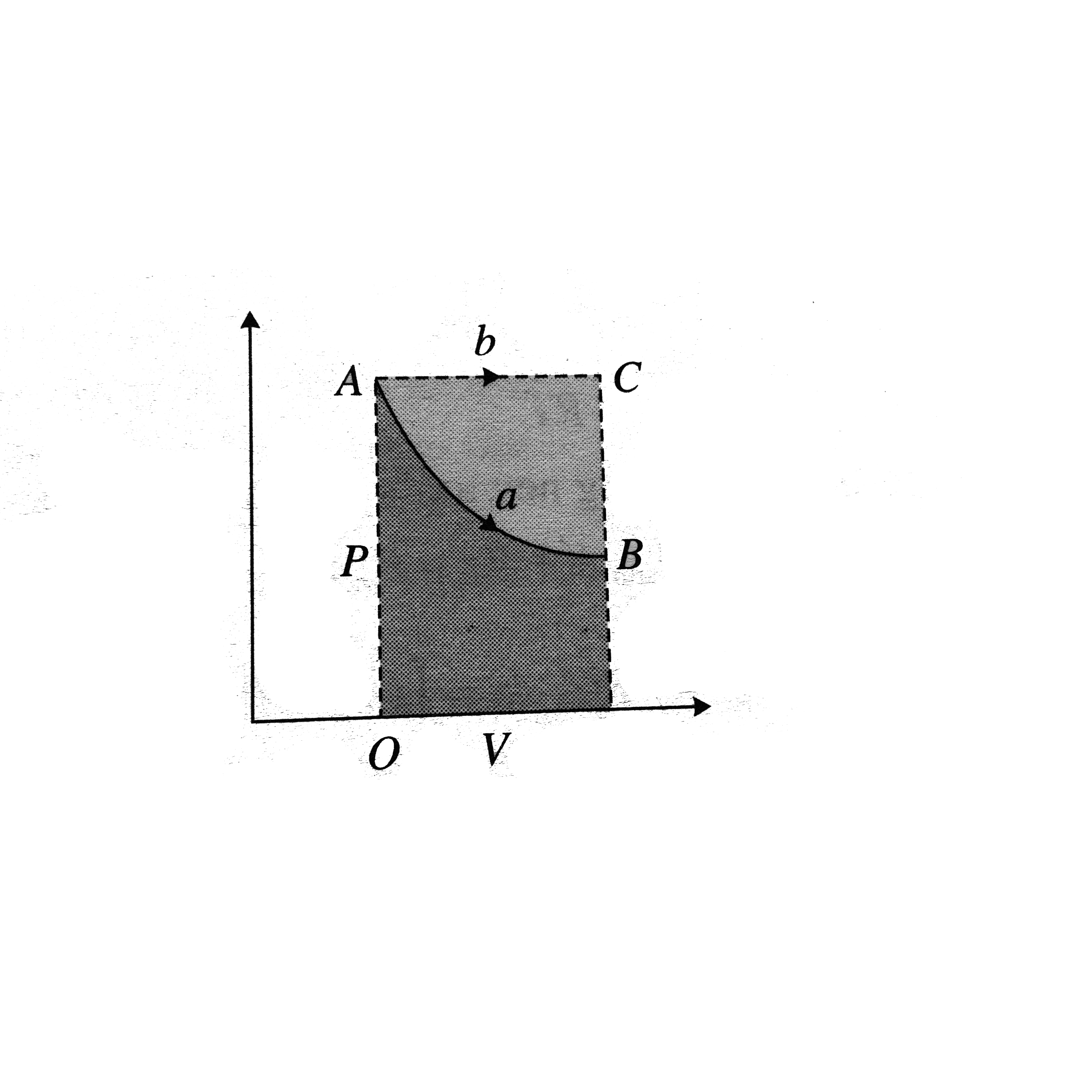 04:58View Solution
04:58View SolutionA sample of ideal gas is expanded to twice its original volume of `1.00m^3` in a quasi-static process for which `p=alphaV^2`, with `alpha=5.00 atm//m^6`, as shown in Fig. How much work is done by the expanding gas?
 04:27View Solution
04:27View SolutionDetermine the work done by an ideal gas doing `1 rarr 4 rarr 3rarr 2 rarr 1`.
Given `P_(1) = 10^(5) Pa, P_(0) = 3 xx 10^(5) Pa, P_(3) = 4 xx 10^(5) Pa` and `V_(2) - V_(1) = 10 L`.
 03:11View Solution
03:11View SolutionAn ideal gas is enclosed in a cylinder with a movable piston on top of it. The piston has a mass of 800 g and an area of `5.00 cm^(2)` and is free slide up and down, keeping the pressure of the gas constant. How much work is done on the gas as the temperature of 0.200 mol of the gas is raised from `20.0^(@)C` to `300^(@)C` ?
02:30View SolutionThe cylinder shown in the figure has conducting walls and temperature of the surrounding is T, the pistonj is initially in equilibrium, the cylinder contains n moles of a gas, Now the piston is displaced slowly by an external agent to make the volume double of the initial. Find work done by external agent in term of n, R, T
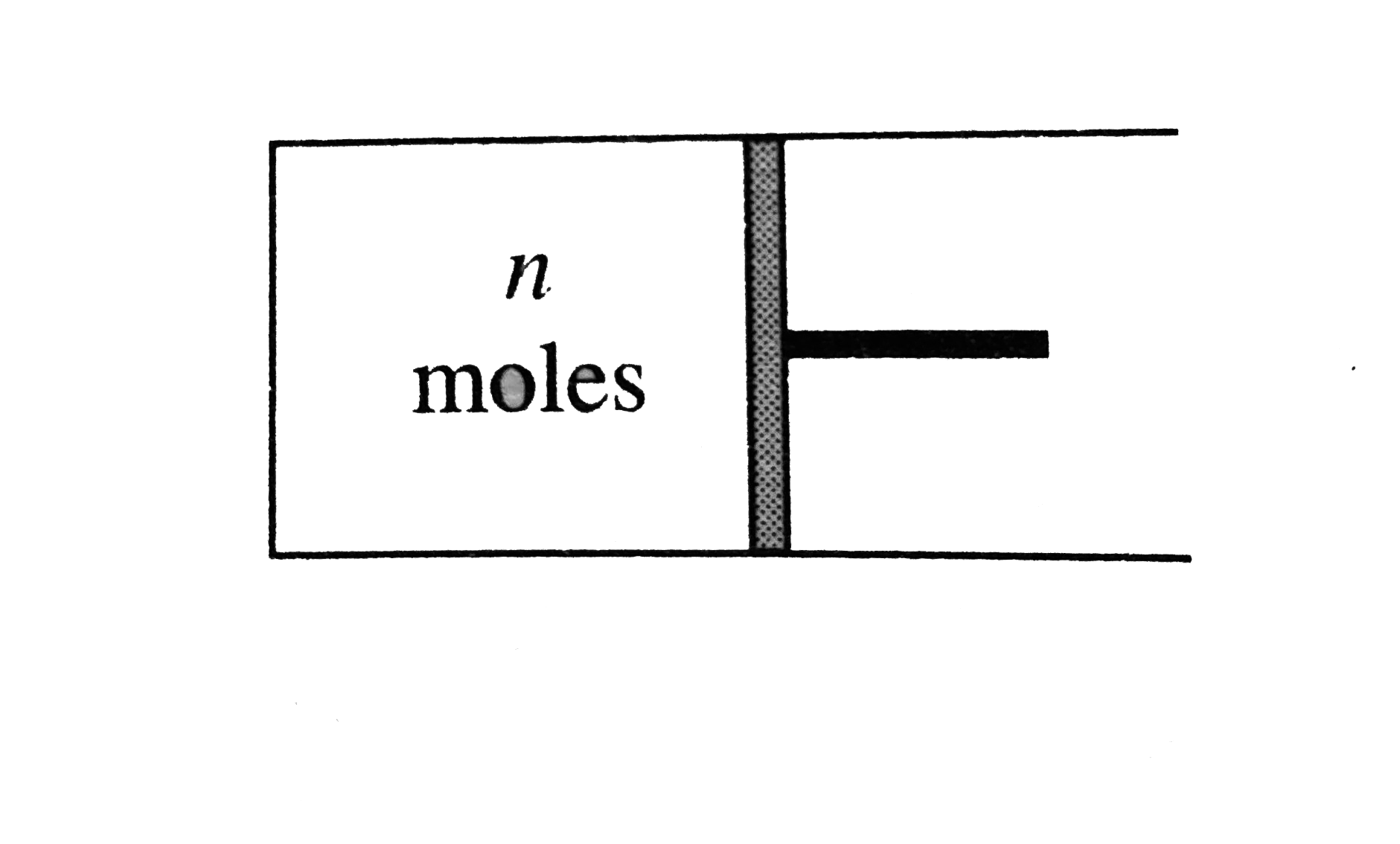 01:53View Solution
01:53View SolutionA non conducting piston of mass m and area of cross section A is placed on a non conducting cylinder as shown in figure. Temperature, spring constant, height of the piston are given by T,K,h respectively. Initially spring is relaxed and piston is at rest. Find
(a) Number of moles
(b) Work done by gas to displane the piston by distance d when the gas is heated slowly.
(c ) Find the final temperature
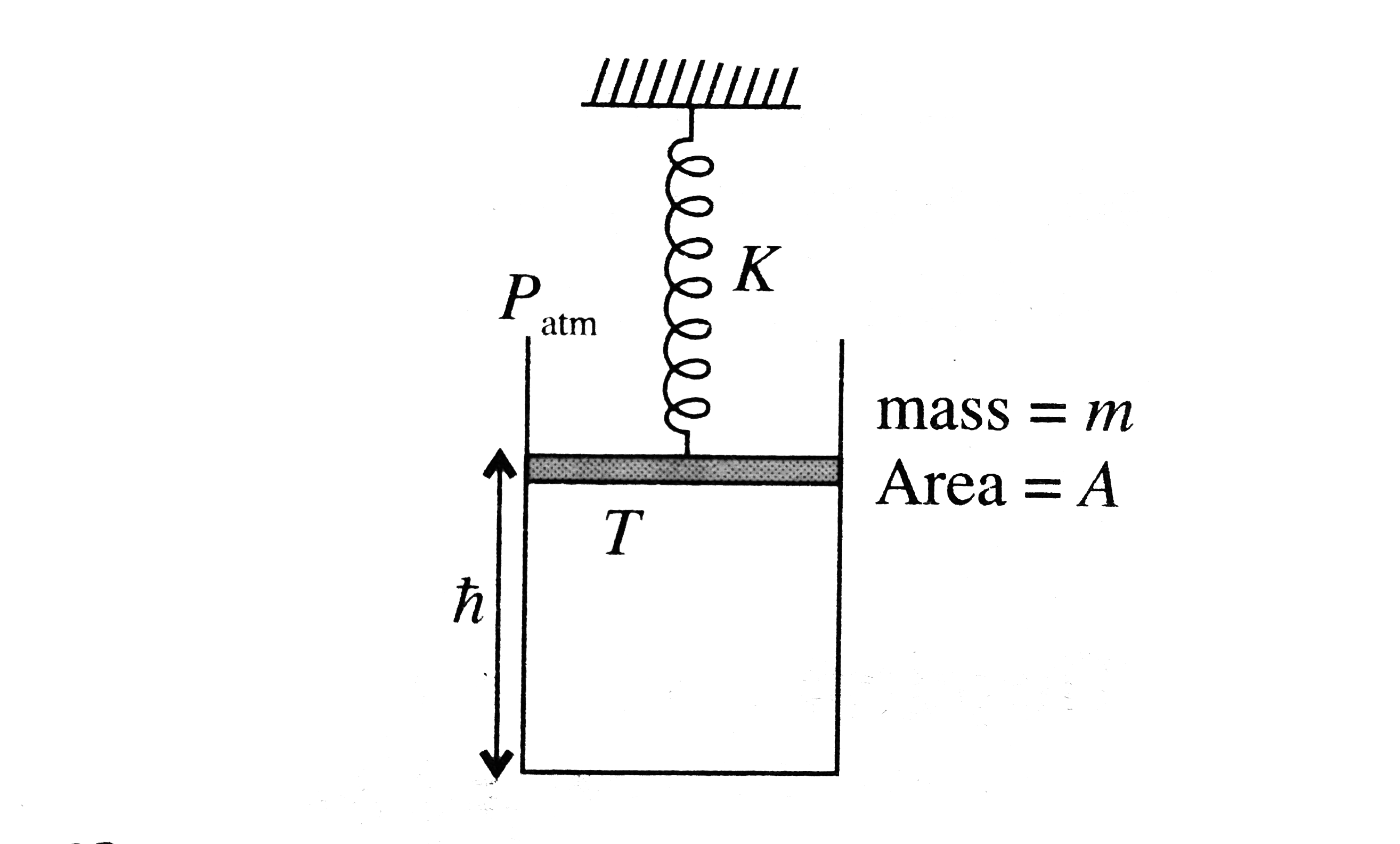 05:14View Solution
05:14View SolutionWhen a thermodynamic system is taken from an initial state I to a final state F along the path IAF, as shown in Fig. the heat energy absorbed by the system is `Q = 55 J` and work done by the system is `W = 25 J`. If the same system is taken along the path IBF, the value of `Q = 35 J`.
(a) If `W = - 15 J` for the curved path FI, how much heat energy is lost by the system along this path ?
(b) If `U_(1) = 10 J`, what is `U_(F)` ?
(d) If `U_(B) = 20 J`, what is Q for the process BF and IB ?08:31View SolutionHow much work is done on the steam when 1.00 mol of water at `100^(@)C` boils and becomes 1.00 mole of steam at `100^(@)C` at 1.00 atm pressure? Assume the steam to behave as an ideal gas , determine the change in the internal energy of the material as it vapourizes.
04:42View SolutionAn ideal gas initially at 300 K undergoes an isobaric expansion at 2.50 k Pa. If the volume increases from `1.00 m^(2)` to `3.00 m^(3)` and 12.5 kJ is transferred to the gas by heat, what are (a) the change in its internal energy and (b) its final temperature ?
05:29View SolutionThe temperature of 3 kg of nitrogen is raised form `10^(@)C` to `100^(@)C`, Compute the heat added, the work done, and the change in internal energy if (a) this is done at constant volume and (b) if the heating is at constant pressure. For nitrogen
`C_(p) = 1400 J kg^(-1) K^(-1)` and `C_(v) = 740 J kg^(-1) K^(-1)`.05:45View SolutionGaseous hydrogen contained initially under standard conditions in sealed vessel of volume `V = 5 L` was cooled by `Delta T = 55 K`. Find how much the internal energy of the gas will change and what amount of heat will be lost by the gas.
03:17View SolutionThe volume of a monatomic ideal gas increases linearly with pressure, as shown in Fig. Calculate (a) increase in internal energy, (b) work done by the gas and (c ) heat supplied to the gas.
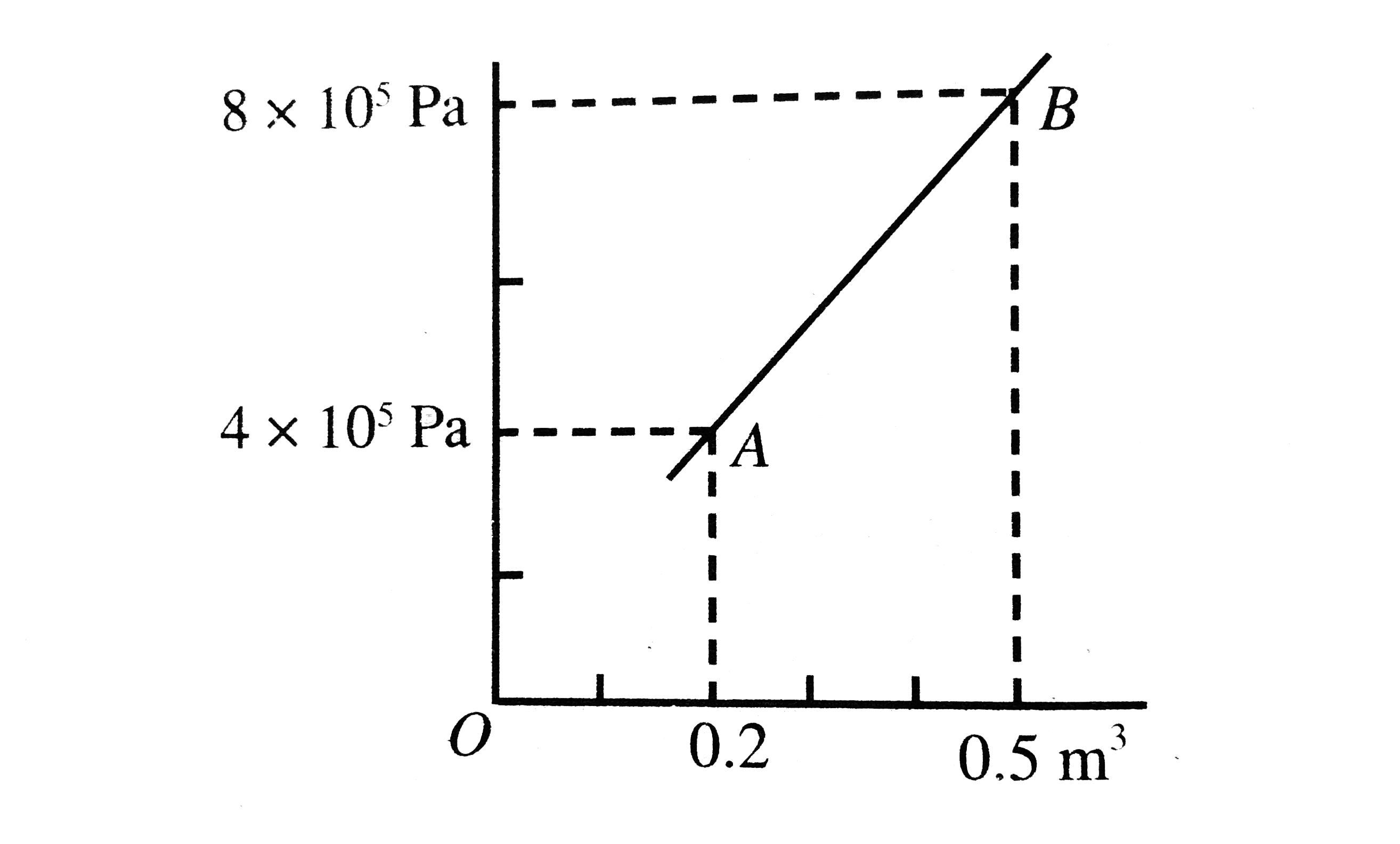 02:50View Solution
02:50View SolutionA Vessel contains helium, which expands at constant pressure when 15 kJ of heat is supplied to it. What will be the variation of the internal energy of the gas? What is the work performed in the expansion?
03:55View SolutionThe volume of one mode of an ideal gas with adiabatic exponent `gamma` is varied according to the law `V = a//T`, where a is constant . Find the amount of heat obtained by the gas in this process, if the temperature is increased by `Delta T`.
03:05View SolutionA 2.00 mol sample of helium gas initially at 300 K and 0.400 atm is compressed isothermally to 1.20 atm. Noting that the helium behaves as an ideal gas, find (a) the final volume of the gas, (b) the work done on the gas and (c ) the energy transferred by heat.
06:11View SolutionAs a result of the Isobaric heating by `Delta T = 72 K`, one mole of a certain ideal gas receives heat Q = 1.6 kJ. Find the work performed by the increment of its intenal energy, and the value of its adiabatic exponent `gamma`.
03:19View SolutionSix grams of hydrogen gas at a temperature of 273 K isothoermally expanded to five times its initial volume and then isochorically heated so that the pressure in the final state becomes equal to that in the initial state. Find the total amount of heat absorbed by the gas during the entire process.
05:12View SolutionTwo moles of an ideal gas at `300 K` cooled at constant volume so that the pressure is reduced to half the initial value. Then as a result of heating at constant pressure. Find the total heat absorbed by the gas, if `R` is the gas constant.
04:13View SolutionT-V curve of cyclic process is shown below, number of moles of the gas are n find the total work done during the cycle.
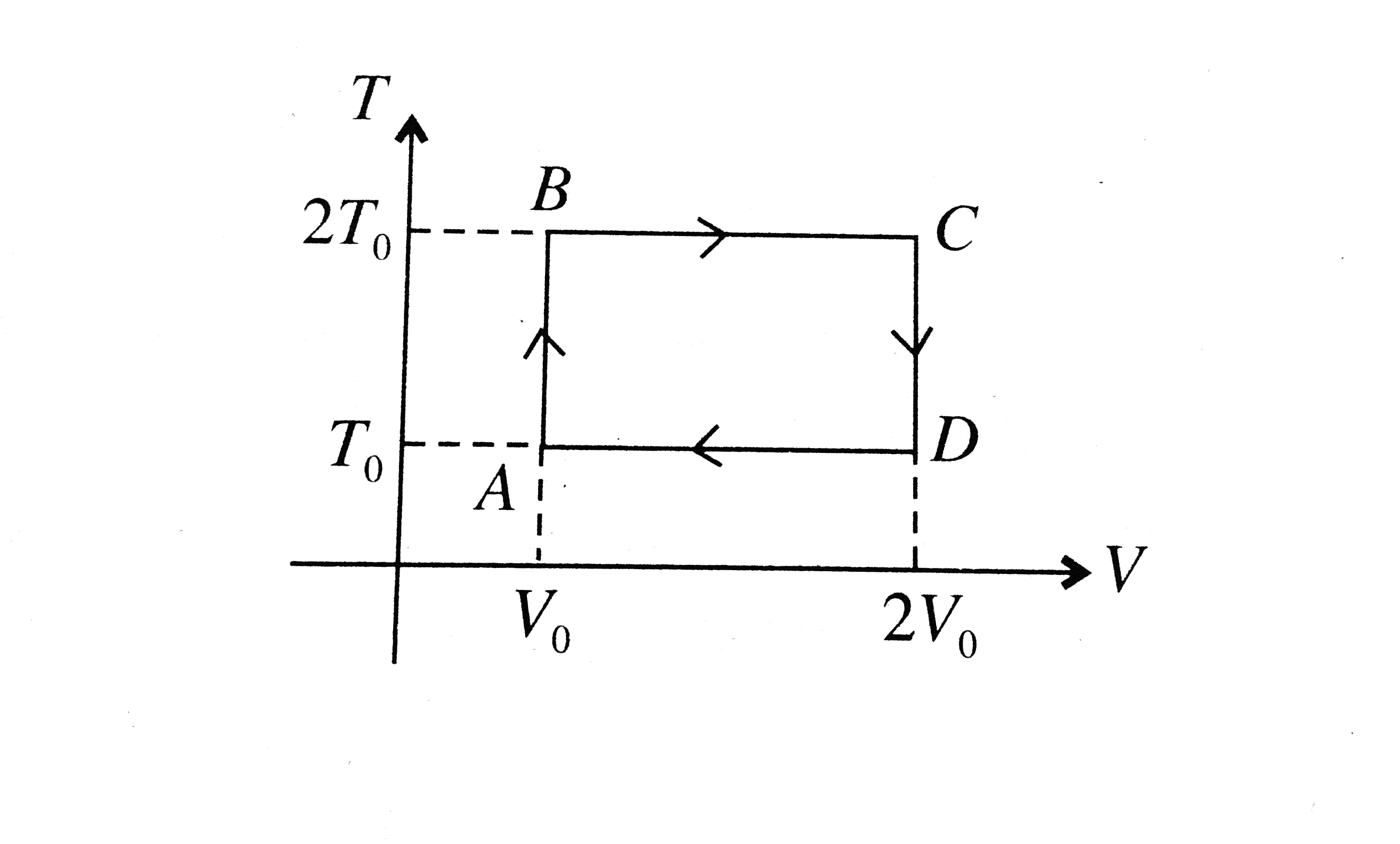 06:51View Solution
06:51View SolutionP-T curve of a cyclic process is shown. Find out the works done by the gas in the given proces if number of moles of the gas are n.
 02:14View Solution
02:14View SolutionIn a cylinder, 2.0 moles of an ideal monatomic gas initially at `1.0 xx 10^(6)` Pa and 300 K expands until its volume doulbles. Compute the work done if the expansion is (a) isothermal, (b) adiabatic and (c ) isobaric.
04:51View SolutionOne mole of a perfect gas, initally at a pressure and temperature of `10^(5) N//m^(2)` and 300 K, respectively, expands isothermally unitl its volume is doubled and then adiabatically until its volume is again doubled. Find final pressure and temperature of the gas Find the total work done during the isothermal and adiabatic processes. Given `gamma = 1.4`. Also draw the P-V diagram for the process.
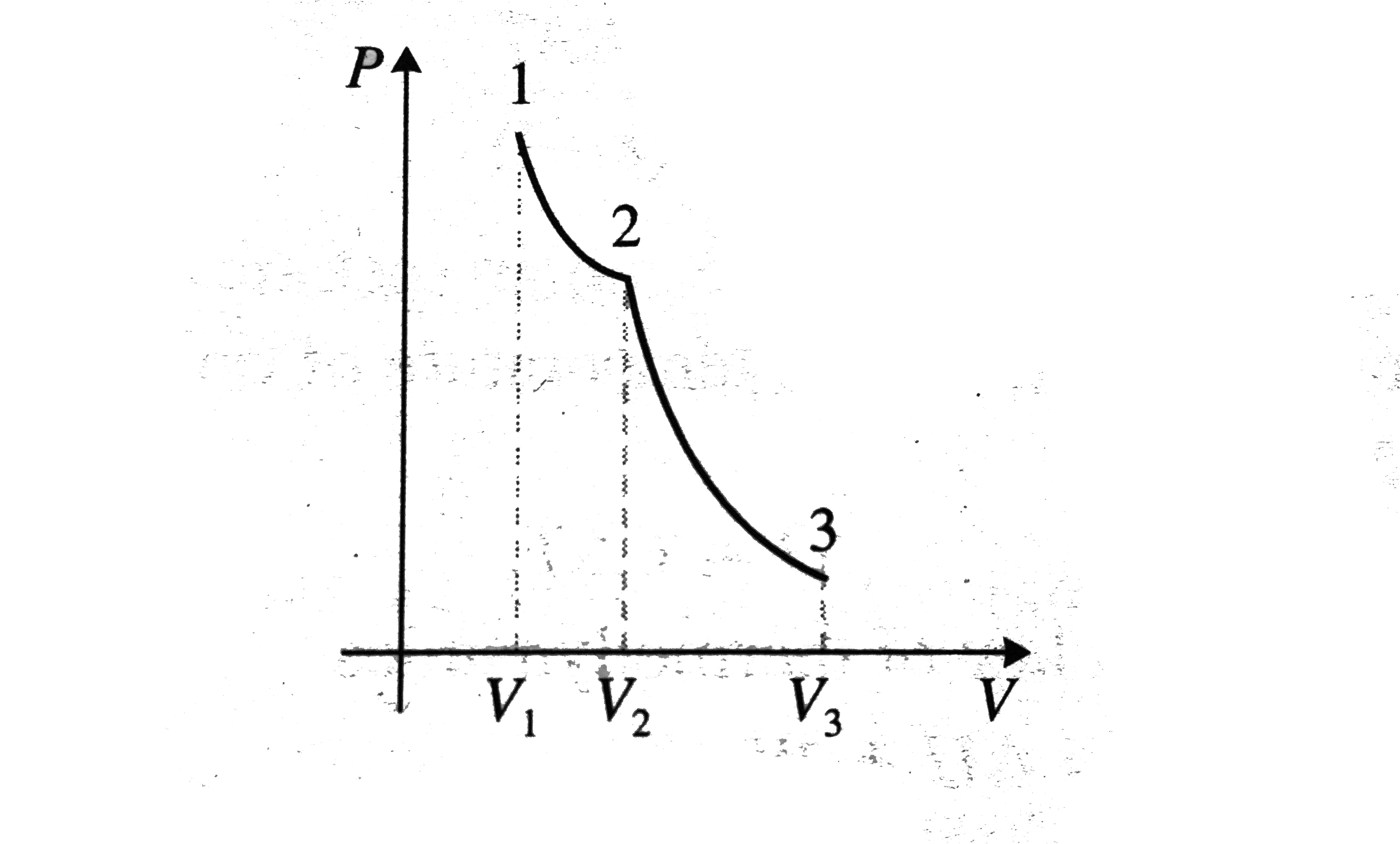 05:39View Solution
05:39View SolutionAn ideal gas `(C_p // C_V = (gamma)` is taken through a process in which the pressure and the volume vary as `P = aV^b`. Find the values of (b) for which the specific heat capacity of the gas for the process is zero.
01:46View SolutionA cylindrical container having non-conducting walls is partitioned in two equal parts such that the volume of the each parts is eqaul to `V_(0)` A movable non-conducting piston is kept between the two parts. Gas on left is slowly heated so that the gas on right is compressed upto volume `V_(0)//8`. Find pressure and temperature on both sides if initial pressure and temperature, were `P_(0)` and `T_(0)` respectively. Also find heat given by the heater to the gas (number of moles in each parts is n)
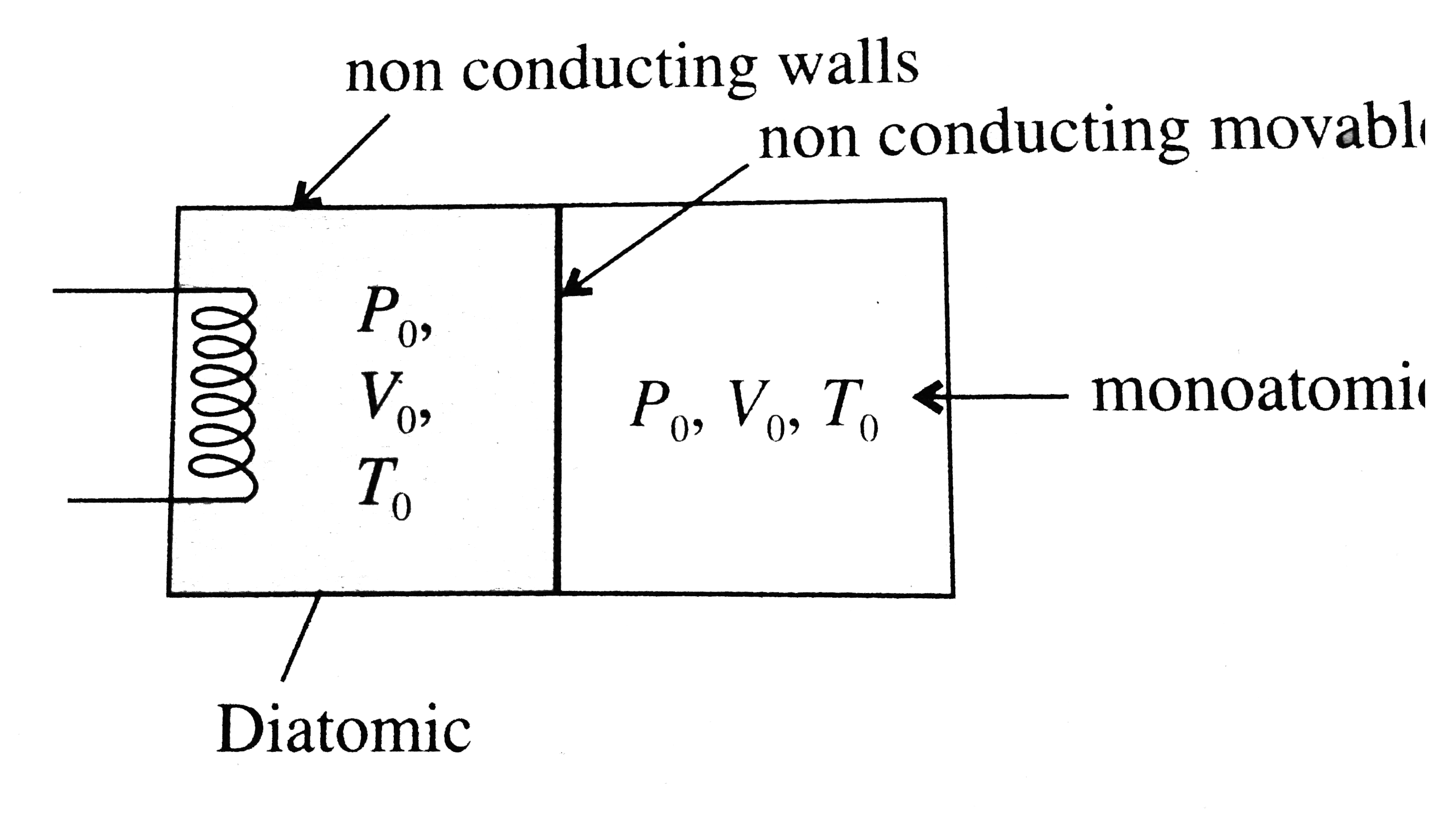 05:43View Solution
05:43View SolutionA reversible heat engine carries 1 mole of an ideal monatomic gas around the cycle 1-2-3-1. Process 1-2 takes place at constant volume, process 2-3 is adiabatic, and process 3-1 takes place at constant pressure. Complete the values for the heat `Delta Q`, the change in internal energy `Delta U`, and the work done `Delta `, for each of the three processes and for the cycle as a whole.
 05:46View Solution
05:46View Solutionconsider the cyclic process ABCA on a sample of 2.0 mol of an ideal gas as shown in the fig. temperature of the gas at A and B are 300 K and 500 k respectively. A total of 1200 J heat is withdrawn from the sample in the process. Find the work done by the gas in part BC. take `R=8.3 JK^(-1) mol^(-1)`
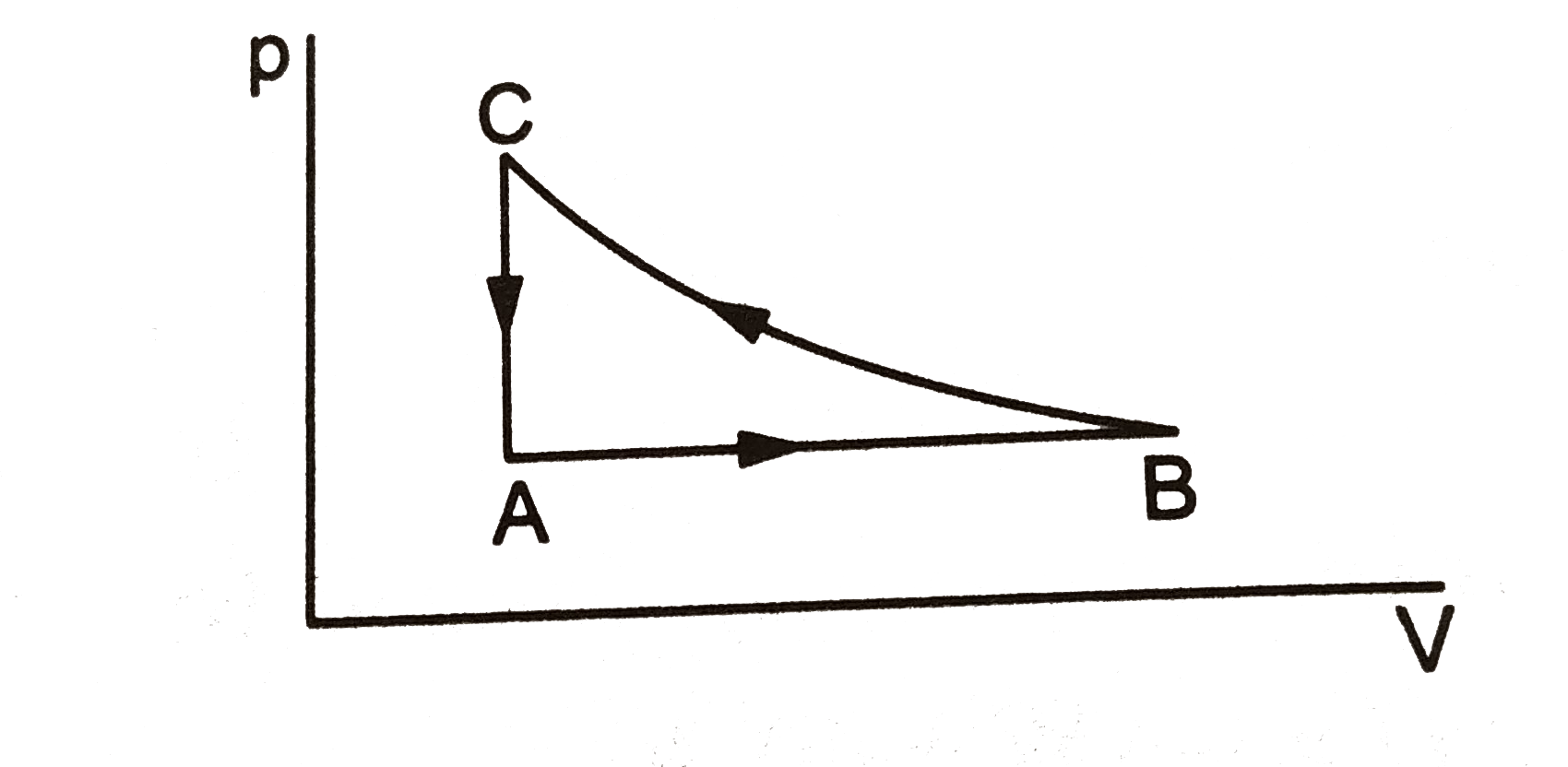 04:03View Solution
04:03View SolutionA sample of an ideal gas has pressure `p_(0)`, volume `V_(0)` and tempreture `T_(0)`. It is isothermally expanded to twice its original volume.It is then compressed at constant pressure to have the original volume `V_(0)`. Finally, the gas is heated at constant volume to get the original temperature.
(a) Show the process in a V-T diagram
(b) Calculate the heat absorbed in the process.06:19View SolutionHelium gas goes through a cycle ABCDA (consisting of two isochoric and two isobaric lines) as shown in figure. Efficiency of this cycle is nearly :
 03:36View Solution
03:36View SolutionThree moles of an ideal gas at a pressure `P_(A)` and temperature `T_(A)` is isothermally expanded to twice its initial volume. It is then compressed at constant pressure to its original , volume. Finally the gas is compressed at constant volume to its original pressure `P_(A)`
(a) Sketch the P-V and P-T diagrams for the complete process.
(b) Calculate the net work done by the gas, and net heat supplied to the gas during the complete process.09:26View SolutionAn ideal gas is taken round a cyclic thermodynamic process ABCA as shown if Fig. If the internal energy of the gas at point A is assumed zero while at B it is 50 J. The heat absorbed by the gas in the process BC is 90 J.
(a) What is the internal energy og the gas at point C ?
(b) How much heat energy is absorbed by the gas in the process AB?
(c ) Find the heat energy rejected or absorbed by the gas in the process CA.
(d) What is the net work done by the gas in the complete cycle ABCA ?
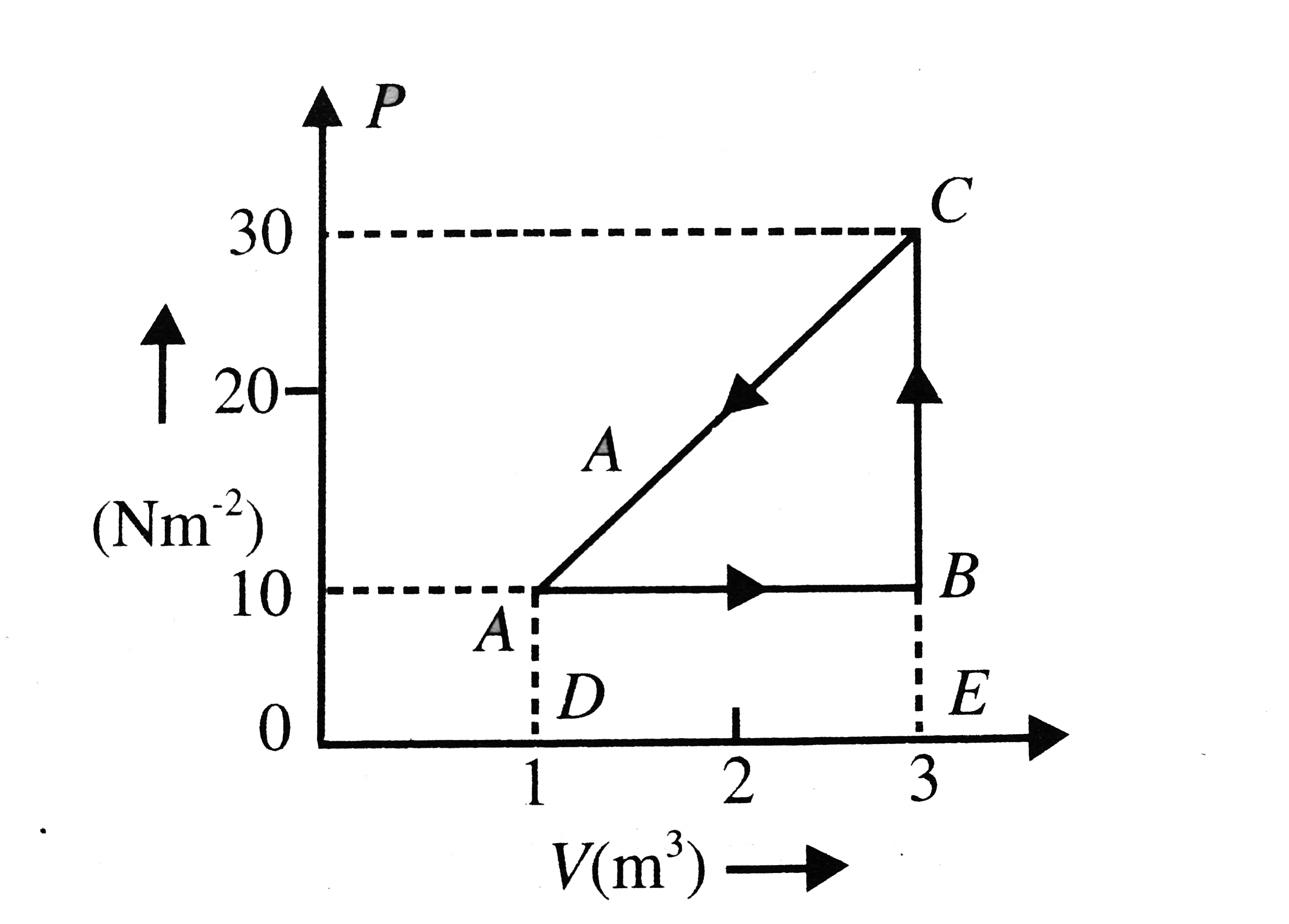 05:42View Solution
05:42View SolutionA fixed mass of oxygen gas performs a cyclic process ABCA as shown. Find the efficiency of the process.
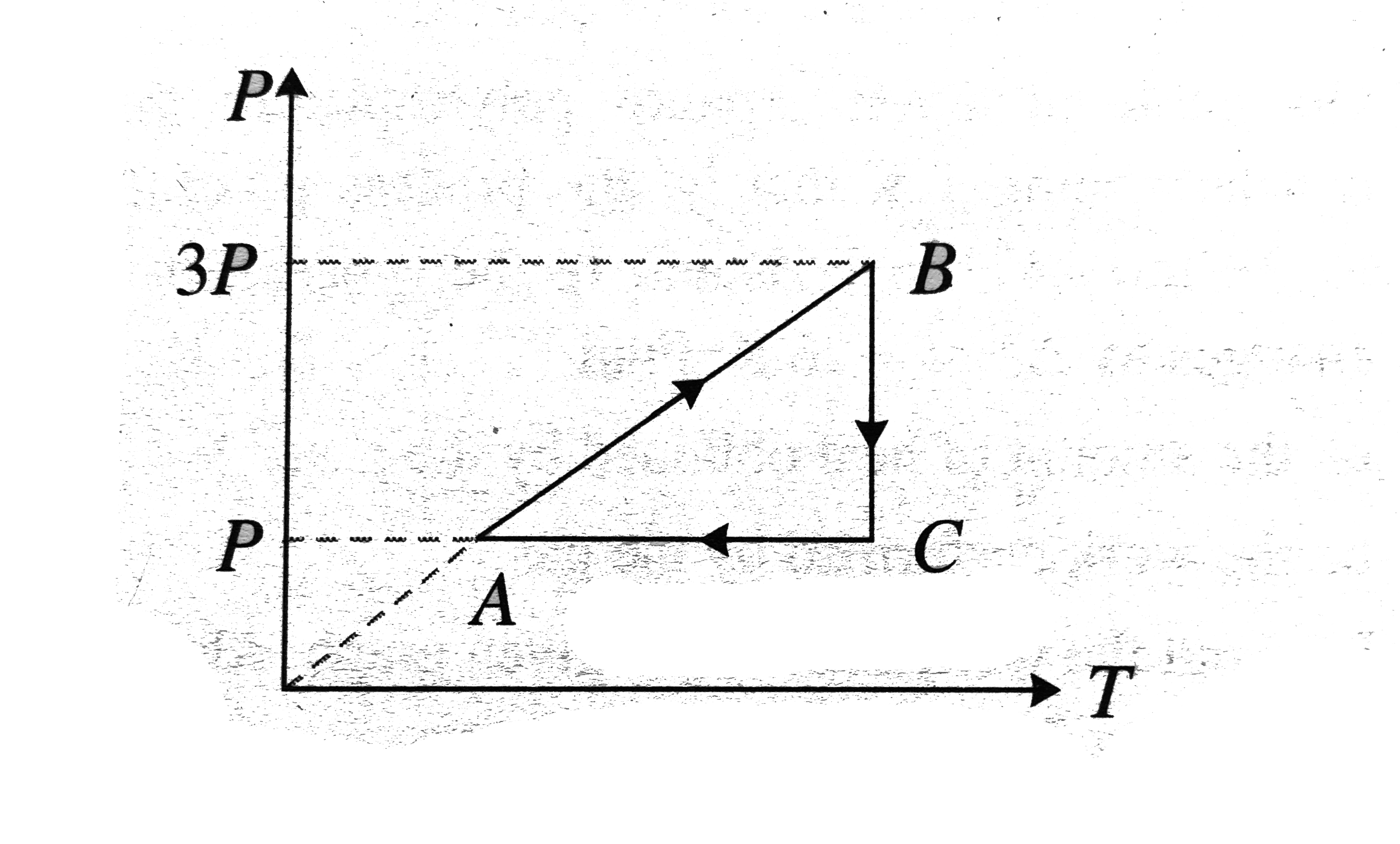 05:16View Solution
05:16View Solutionn moles of a diatomic gas has undergone a cyclic process ABC as shown in figure. Temperature at a is `T_(0)`. Find volume at C
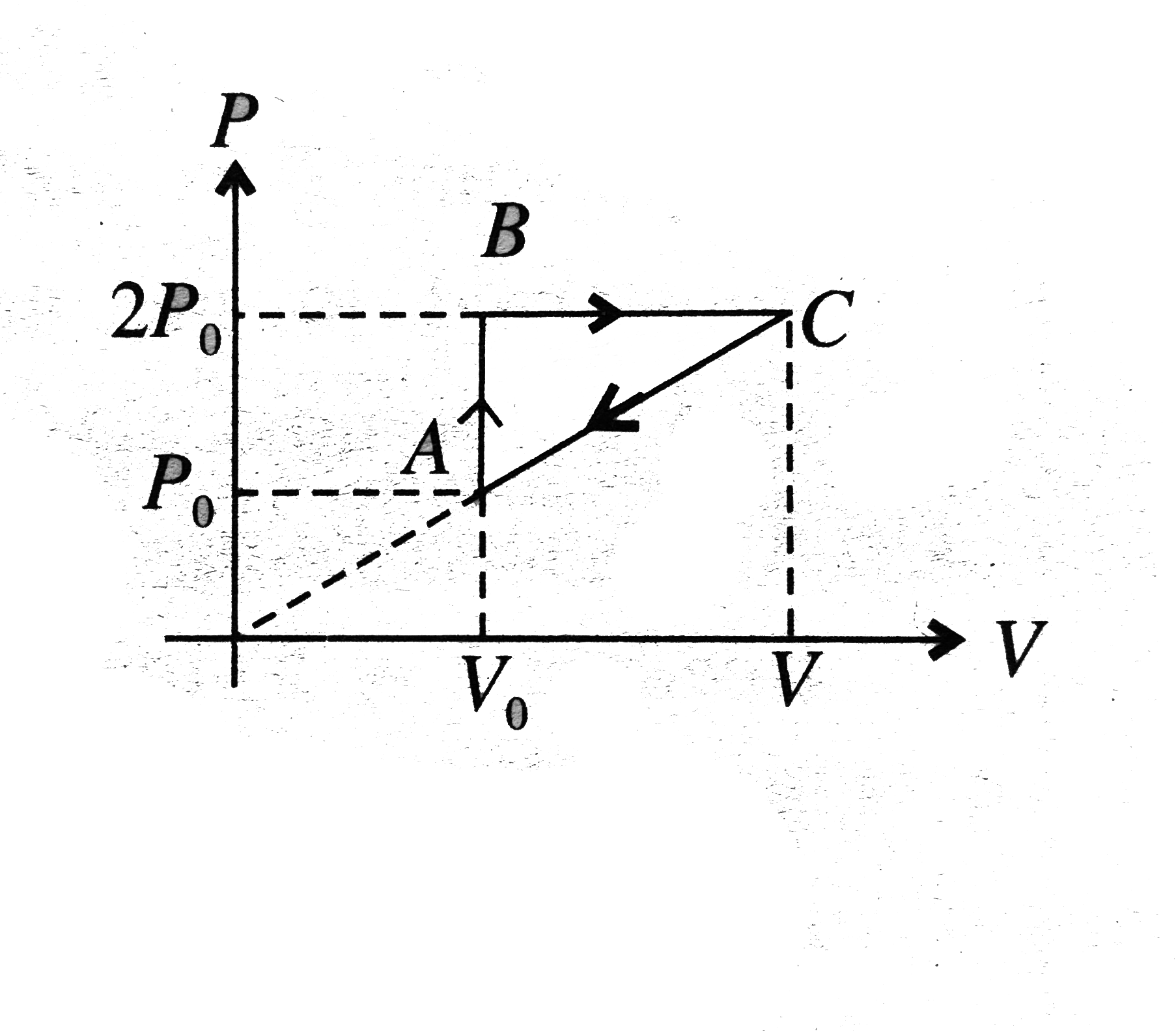 02:08View Solution
02:08View Solution
Illustration questions and complete solutions for chapter KINETIC THEORY OF GASES AND FIRST LAW OF THERMODYNAMICS of CENGAGE PHYSICS (ENGLISH) of Class 11
